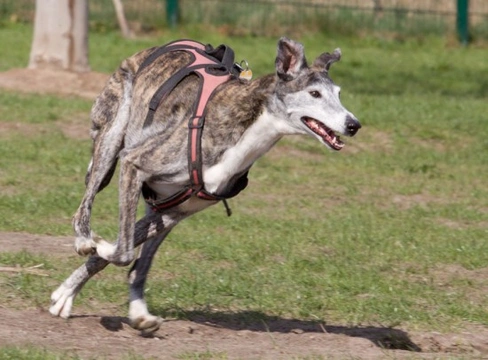
Retired Racing Greyhounds as Pets
Background
The greyhound is a very old breed, much revered by the ancient Egyptians. Along with other breeds such as the Afghan Hound, Saluki and Borzoi, they are sighthounds. That means they rely on spotting moving prey in the distance when hunting. Then, they give chase at around 35mph. So, over time, this speed and skill was utilised for sporting purposes. Now, greyhound racing is one of the most popular spectator sports in the UK. There are more than 20 racetracks around the country, with each track holding 2 or 3 race meetings every week. All those races require a lot of dogs and about 10,000 of them retire from racing each year. Some stay with their owners but that still leaves a huge number of dogs looking for homes. They're usually aged around 4-5 years at retirement but some dogs retire earlier due to injury or simply because they're not very successful. As well as a number of specialist greyhound rescue organisations (easily found on an internet search), just about all dog rescue charities, large and small, will have greyhounds on their books too. Most of the racing dogs in the UK are bred in Ireland - you can tell by checking their ear tattoos, which all registered greyhounds have. Irish-bred dogs have letters tattooed in both ears while the British-bred ones only have one ear marked. In Ireland, the greyhounds often spend the first year of their life living outside, as a pack, fending for themselves and having little human contact. Then, when their racing life begins, they live in kennels. Doesn't sound like the ideal basis for a family pet.....
The truth about Greyhounds
But, here's the thing - greyhounds are fabulous pets. They are affectionate, friendly, easy-going and they adapt well to living in a home. They are very popular as therapy dogs due to their calm temperament. They are not known to have genetic health problems but do sometimes suffer from corns which are unique to greyhounds and greyhound crosses. There can be quite a difference in size, ranging from a small bitch weighing around 25kg to a large male weighing over 40kg. They also come in a variety of colours - but for some unknown reason, black dogs seem to be the least popular for rehoming. The coat is short and easy to care for. Many people believe that ex-racing greyhounds need lots of exercise but this is simply not true. They are sprinters so enjoy a short burst of speed now and again but are equally happy on a relaxed stroll or doing absolutely nothing at all. There is also the belief that a greyhound will chase and kill all other small animals. Greyhounds often learn to live with small dogs, cats and other animals in their own "pack" but will probably still be tempted to chase wild animals or someone else's pets, but the same could be said of any breed of dog. The chasing instinct may depend on exactly how the dog has been trained and does need careful management in the early days in their new home. And it's likely the only other dogs they've met before will have been other greyhounds. They simply may not recognise other breeds as being dogs with their different shapes, sizes, coat lengths, face shapes, etc.
Everyday Practicalities
Due to their previous lifestyle, there are a few quirks to be aware of.
- Walking nicely on the lead is usually part of the training for the racing life (for the pre-race parade around the track) and they're usually used to car travel too. However, when off lead, you may find that a greyhound will run off and expect you to go and get him. After all, that's what happens at the end of a race - the handlers go and get the dogs when they stop running.
- If a dog is clean in its kennel (ie not using it as a toilet) this will tell you if toilet training will be needed at home.
- They won't be used to everyday things around the house - stairs, TV, washing machine, patio doors, for example - but a little time and patience will help get them get used to these things.
- Due to the long legs and muscle structure, the sit position isn't really possible for a greyhound so don't expect to be able to teach that - settle for getting the dog to stand still when necessary eg at the kerb when crossing the road.
- For the same reason, and possibly also due to aching injured joints, lying down on the floor (and getting up again) can be tricky too. In kennels, the bed is usually on a raised platform, so on arrival at a new home, a greyhound will expect to find the same there and head for the nearest sofa or bed - it's just easier to get on & off. So you would need to ensure your greyhound knows where his bed is and that your furniture is off-limits - if that's what you want.
So, if you're considering which dog you want to share your home and life with, giving an ex-athlete a comfortable and happy retirement is a very rewarding experience.



